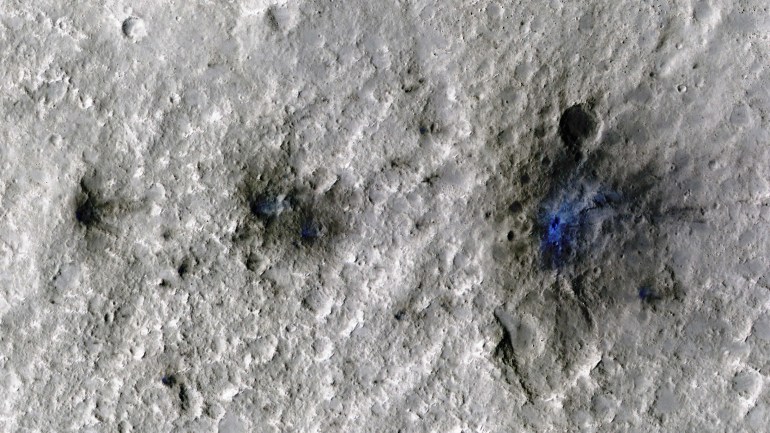NASA’s InSight lander detects space rocks, craters on Mars
InSight detects seismic and acoustic waves from meteorites and calculates location of craters – the first such measurements outside Earth.

Mars, by virtue of its tenuous atmosphere and proximity to our solar system’s asteroid belt, is far more vulnerable than Earth to being struck by space rocks – one of the many differences between the two planetary neighbours, say space scientists.
Scientists are now gaining a fuller understanding of this Martian trait, with help from NASA’s robotic InSight lander.
Keep reading
list of 4 itemsSouth Korea’s first Moon orbiter launched into space
What’s the future of the International Space Station?
‘A new era’: NASA unveils more Webb Telescope images of universe
Researchers on Monday described how InSight detected seismic and acoustic waves from when four meteorites hit its surface and then calculated the location of the craters they left – the first such measurements anywhere other than Earth.
The researchers used observations from NASA’s Mars Reconnaissance Orbiter in space to confirm the crater’s locations.
“These seismic measurements give us a completely new tool for investigating Mars, or any other planet we can land a seismometer on,” said planetary geophysicist Bruce Banerdt of NASA’s Jet Propulsion Laboratory, the InSight mission’s principal investigator.

Moon also a target
The space rocks InSight tracked – one landing in 2020 and the other three in 2021 – were relatively modest in size, estimated to weigh up to about 440 pounds (200kg), with diameters of up to about 20 inches (50cm) and leaving craters of up to about 24 feet (7.2 meters) wide.
They landed between 53 miles (85km) and 180 miles (290km) from InSight’s location. One exploded into at least three pieces that each gouged their own craters.
“We can connect a known source type, location and size to what the seismic signal looks like. We can apply this information to better understand InSight’s entire catalog of seismic events, and use the results on other planets and moons, too,” said Brown University planetary scientist Ingrid Daubar, a co-author of the study published in the journal Nature Geoscience.

The researchers believe that now the seismic signature of such crashes has been discovered they expect to find more contained in InSight’s data, going back to 2018.
The three-legged InSight – its name is short for Interior Exploration Using Seismic Investigations, Geodesy and Heat Transport – landed in 2018 in a vast and relatively flat plain just north of the Martian equator called Elysium Planitia.
“The moon is also a target for future meteor impact detection,” said planetary scientist and study lead author Raphael Garcia of the University of Toulouse’s ISAE-SUPAERO Institute of Aeronautics and Space.
“And it may be the same sensors will do it, because the spare sensors of InSight are currently integrated in the Farside Seismic Suite instrument for a flight to the moon in 2025,” Garcia added, referring to an instrument due to be placed near the lunar south pole on the side of the moon permanently facing away from Earth.
‘Hundreds of impacts’
Mars is about twice as likely as Earth to have its atmosphere hit by a meteoroid – the name for a space rock before it strikes the surface. However, Earth has a much thicker atmosphere that protects the planet.
“So meteoroids usually break up and disintegrate in the Earth’s atmosphere, forming fireballs that only rarely reach the surface to form a crater. In comparison on Mars, hundreds of impact craters are forming somewhere on the planet’s surface every year,” Daubar said.
The Martian atmosphere is only about 1 percent as thick as Earth’s. The asteroid belt, an abundant source of space rocks, is located between Mars and Jupiter.
InSight’s seismometer instrument established that Mars is seismically active, detecting more than 1,300 quakes on the planet. In research published last year, seismic waves detected by InSight helped decipher the internal structure of Mars, including the first estimates of the size of its large liquid metal core, the thickness of its crust, and the nature of its mantle.